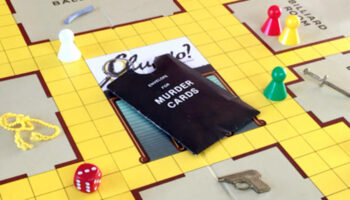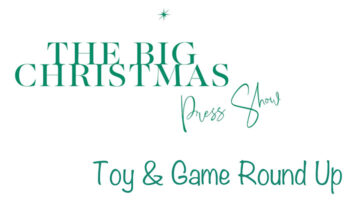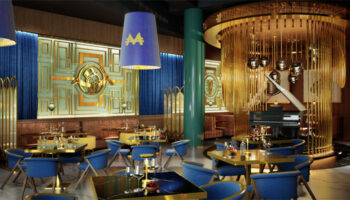Why design? Industry figures tell us what set them on the path to design

A love of toys? An inspirational teacher? An eye-opening exhibition? We asked figures from across the world of toy and game design what set them on the path to working in design and development…

Nikki Bauman, Manager of Fisher-Price Inventor Relations, Mattel
“What inspired me to go into product design was the Biomedical Engineering program at Wright State University in Ohio. It’s where I started college and set on my path to designing prosthetics, initially. Two years into the program, i realised how grossed out I was by Anatomy and Physiology class… And having to dissect roadkill – blegh! I then changed course and transferred into the Industrial Design program at the University of Cincinnati. I was much more comfortable designing furniture and electronics – not quite as gross! Then I discovered my love of toy design after two internships at Fisher-Price. 13 years into toy design at Fisher-Price, I’ve switched gears again and been on the Inventor Relations team for six years. It’s been a very long and winding path that’s landed me on my favourite team so far!”
 Ste Smith, Creative Director, WITH Creative
Ste Smith, Creative Director, WITH Creative
“I was always curious about how things were made. Much to my Mum’s frustration, taking things apart to see how they were built – and sometimes not being able to put them back together again… But I really became obsessed when I got my first Super Soaker. A few pumps and I could spray my friends from a distance. I vividly remember the moment where – while hiding for cover during a battle – I looked down at my gun and thought ‘It was someone’s job to create this drench weapon?! I want that to be my job!’ Not only was I fascinated with how it was made, it was the why it was made that really gripped me. Those feelings of joy and the fun memories it creates, that’s why this thing existed. Every product I’ve designed and created in my career has been focused on sparking feelings of joy and happiness. That is why I do what I do.”
 Alex Reynolds, Head of Research & Development, Casdon
Alex Reynolds, Head of Research & Development, Casdon
“I’d go for TOMY’s Kong Man. I was always obsessed with how all the internal mechanisms created such an amazing and magical play experience… The magnetic wall was my favourite! As a child, I used to take it apart and be mesmerised by what seemed like millions of pieces all working in unison behind the scenes. Since then, I’ve always had the inclination to take things apart, see how they really work, and it’s inspired me to design my own toy mechanisms that bring ‘magic’ to kids.”
 James Austin-Smith, Director of Innovation, Moose Toys
James Austin-Smith, Director of Innovation, Moose Toys
“I’m not sure that this put me on the path to toy invention consciously, but in an unconscious way my childhood toys had a big effect on me, igniting a passion that was never met until the world of toy design opened up to me. Starcom in particular had an awesome blend of ‘imaginative storytelling supported by a little moment of magic’ to produce the surprise and delight that I look for in my work today. It was a classic 80’s space-themed range of vehicles and pilots. The pilots had magnetic boots that activated features on the vehicles and allowed them to defy gravity as they clung to plates on the sides of the ships. The magnetic boots also triggered transformations in the vehicles and playsets that were powered by clockwork mechanisms, meaning they never needed batteries and made an awesome buzzing sound as they activated. It was great fuel to roleplay space adventures to, and has always stayed in my memories as an immersive experience powered by a great mechanism, married with an exciting execution.”
 Phil Sage, Senior Director, Design & Innovation HUB, North America, PepsiCo
Phil Sage, Senior Director, Design & Innovation HUB, North America, PepsiCo
“At university, I would take the train from Swansea to London, and open my mind to the impossible. I was fascinated with getting around on the London Underground. Some describe it as organised chaos, but I appreciated its holistic system design. It gave me a deeper appreciation of how a product experience was made up of so many layers. It was designed that way; the system architecture, the trains, the technologies, the signal systems, the payment systems, the front-facing iconography and flow diagrams explaining where you are and where to go… They all need to talk in order to be efficient and embraced by its users, over and over again.”
 Barry McLaughlin, Co-Founder, Barry & Jason Games
Barry McLaughlin, Co-Founder, Barry & Jason Games
“As a kid I was fascinated by mechanical games with clever analog designs. I loved the simple-yet-satisfying action created by pushing down the lever to make a hippopotamus munch on some tasty marbles in Hungry Hungry Hippos. Or the use of gravity to send flaming orbs careening down the mountain in Fireball Island. Even KerPlunk had a special place in my heart, using the simplicity of a tube, some sticks and a bunch of marbles to create a pretty action-packed game… Whoa! I had no idea that the use of marbles in game design was so special to me until listing those three games together. What a breakthrough! How much do I owe for this session, doc? As for Barry & Jason, we carry this childhood wonder forward with creations that are simple, clever, and analog; with rich illustrations that often include backstories. And up next… Bring me my marbles!”
 Luc Hudson, Co-Founder, Triclops Studio
Luc Hudson, Co-Founder, Triclops Studio
“I didn’t have a huge collection of toys as a kid – unfortunately I can’t say the same now! But I did have – and still have – my original Boglin. I was obsessed with Jim Henson and his movies like Labyrinth and The Dark Crystal. I was fascinated by animatronics and the Boglin was like entry-level puppetry. While still at school, I made a clay head and tried to cast a puppet head from it, coating it with lots of layers of liquid latex. That interest in ‘bringing toys to life’ stayed with me through my early years as a designer when I made mechanical toys and automata – I think I get my mechanical mind from my Dad who is a car nut, specialising in the restoration of vintage Citroens.”
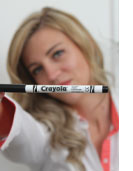 Fi Murray, Founder, Making Things Studio
Fi Murray, Founder, Making Things Studio
“For me it was Crayola and their ‘sticks’ as we call them… Crayons, markers, pencils and so on! They not only opened my eyes to what a wonderful product experience feels like – from the iconic scents of their ink and wax to the quality of the lay down, to the packaging and design – but they also gave me the tools to create, to doodle and to have colouring-in competitions with my nan, Iris. She’d get me a colouring book, get me to pick a page and give me 50p if she thought I did a better job than her. She wasn’t a fan if I didn’t stay in the lines or started drawing something else! That was probably an early sign that I didn’t have the make-up to be a methodical detail designer!”
 Richard Heayes, Founder, Heayes Design and PlayLenz
Richard Heayes, Founder, Heayes Design and PlayLenz
“I first started to think about design being something different from art when I watched Thunderbirds, Joe 90, Captain Scarlet and Space: 1999 as a kid – I was an Anderson fanboy for sure! I loved the different spacecrafts, vehicles and gadgets which made me want to imagine what else International Rescue might need and how those might work. I used to draw up ideas and make them in LEGO! It wasn’t just how something looked but also how it functioned and how cool it was overall. My father was an engineer, so I learnt how to use basic workshop tools when I was fairly young and this gave me confidence to make stuff from what was lying around. From there, I continued to design spacecrafts, gadgets and imaginary objects of the future at school. I only discovered Industrial Design was a ‘thing’ once I left senior school, but luckily I found the perfect college and went onto study I.D. After working in I.D. for a few years, I discovered toys and games and never looked back. I try to keep that eight-year-old me front of mind even though the 50-year-old me often spoils the party with practical issues like costs and feasibility!”
 Darren Lee Phillipson, Toy & Content Development Architect, Design Lead Play
Darren Lee Phillipson, Toy & Content Development Architect, Design Lead Play
“One of my biggest, singular creative inspirations as a young designer was when I came across an article about the 1980’s Italian design movement called Memphis. Designers such as Michele De Lucchi, Ettore Sottsass and Martin Bedin created products with geometric shapes in bold colours and patterns. Their creations really spoke to me and certainly helped to inform my own personal design language and overall approach to product and toy design.”
 David Snow, Owner, The Fantastic Factory
David Snow, Owner, The Fantastic Factory
“Product development came later in life for me; I was focused on a career in sales. It wasn’t until I was pitching to the BBC to get the rights for a Top Gear board game… Once we’d been through that development process, I got the bug and had a hand in developing lots more games. Developing these games was how I met my business partner, Steve; an all-round creative genius – that’s how we started The Fantastic Factory.”
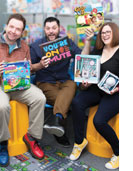 Gary Pyper, Founder, Fun-Damental Invention
Gary Pyper, Founder, Fun-Damental Invention
“I was a 16-year-old art student on a college trip to Barcelona, when – due to a San Miguel induced stupor – I opted to skip visiting Gaudi’s masterpiece The Sagrada Familia to instead wander around the shops aimlessly. That afternoon, I purchased a souvenir that has made a huge impact on how I have approached industrial design since. The object is the Christy sugar bowl produced by Alessi – but, more importantly, it was designed by Dr Christopher Dresser. Aesthetically, you might ‘place’ the bowl in the last few decades, but it was, in fact, first produced in 1885. A masterclass in playful and timeless design, with a single-shot plastic 20c twist. If I can recreate anything half as elegant and as timeless as this in my lifetime, I’ll be eternally satisfied.”
 Geoff Smyrk, VP, Global Creative Director, The Marketing Store London
Geoff Smyrk, VP, Global Creative Director, The Marketing Store London
“For me, it was the LEGO Tug Boat. Just imagine a boat, that comes in bits – even the hull – and is made from relatively heavy parts, that you build and actually floats in the bath. It blew my mind!”
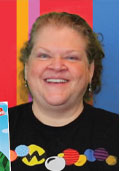 Peggy Brown, Owner, Peggy Brown Creative Consulting
Peggy Brown, Owner, Peggy Brown Creative Consulting
“My story isn’t really about a product – I got my degree in Industrial Design, and the first job I took after graduation was as a staff designer at a game company: Western Publishing, which was later bought by Hasbro. My other options at the time were jobs at a tractor/farm equipment manufacturer, and at a company that made pots and pans. Not very exciting! Woowoo!”
–
To stay in the loop with the latest news, interviews and features from the world of toy and game design, sign up to our weekly newsletter here





